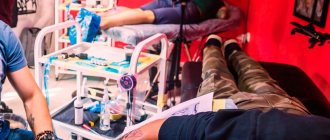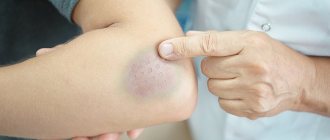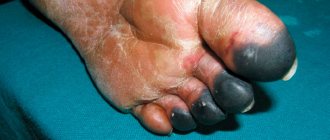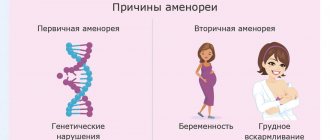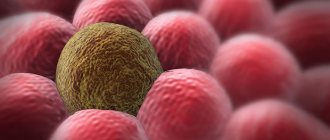1.General information
Gas gangrene is one of the most severe forms of infection caused by anaerobic (living only in the absence of air) pathogenic microorganisms. Once upon a time, gangrene, being a rapidly progressing life-threatening condition, was one of the most common causes of death and loss of limbs, for example, in military field medicine, where in pre-antibiotic times the possibility of primary surgical treatment of wounds was very limited, and their infection, on the contrary, was almost guaranteed .
However, even today gas gangrene, with all its inherent threats, is encountered in traumatological, infectious-parasitological, general and vascular surgical practice, continuing to claim the lives of patients.
A must read! Help with treatment and hospitalization!
TREATMENT AND DRUGS
Tissue damaged by gangrene cannot be saved, but steps can be taken to prevent gangrene from progressing. These procedures include:
Surgery.
Removing dead tissue by a doctor helps stop the spread of gangrene and allows healthy tissue to heal. If possible, your doctor may repair damaged blood vessels to increase blood flow to the affected area. Skin grafting is a type of reconstructive surgery that is used to repair skin damage caused by gangrene. During a skin graft, the doctor removes a piece of healthy skin from another part of your body—usually a place hidden under clothing—and carefully transfers it to the affected areas. Healthy skin can be held in place with a bandage or a few small stitches. A skin flap can only take root if adequate blood supply has been restored to the damaged area of skin.
In severe cases of gangrene, the affected body part, such as a foot, toes or limb, may need to be surgically removed (amputation). In some cases, a prosthesis may be used later.
Antibiotics.
Antibiotics given through a vein (intravenously) can be used to treat gangrene that is caused by infection.
Hyperbaric oxygen therapy.
Hyperbaric oxygen therapy can be used to treat gas gangrene. Under increased pressure and increased oxygen content, the blood is able to deliver more oxygen. Oxygen-rich blood inhibits the growth of bacteria that multiply in the absence of oxygen and helps infected wounds heal more easily.
With this type of therapy, you will be in a special chamber, which usually consists of a table that slides into a special tube chamber. The chamber contains pure oxygen, and the pressure inside the chamber will slowly increase, approximately two and a half times greater than normal atmospheric pressure. During the treatment session, you may feel dizzy and tired.
Hyperbaric oxygen therapy for gas gangrene usually lasts about 90 minutes. You may need up to three sessions on the first day of hyperbaric oxygen therapy, then twice daily for up to five days.
Other treatments for gangrene may include supportive care, including infusions of fluids, nutrients, and pain medications to relieve pain.
2. Reasons
Of all the anaerobes that can cause gas gangrene, the most widespread and studied is the genus Clostridia - an opportunistic rod-shaped bacterium that is sown in approximately every fourth healthy person (it lives in the intestines, vagina, and is sometimes found in saliva and on the oral mucosa). Over ten of the most dangerous types of clostridia are known, the abnormally active activity of which leads to the development of gas gangrene in its various forms, and also causes botulism, severe diseases of livestock, etc.
Clostridia can develop, actively reproduce and secrete deadly toxins only in airless environments, i.e. They are obligate anaerobes - oxygen in the air is harmful to them. However, the spores they form are able to survive for quite a long time in the environment, and in the etiopathogenesis of gas gangrene, infection of the wound by soil is of great importance, especially if this soil contains cattle manure.
Dead organic matter serves as a breeding ground for pathogenic bacteria, so anaerobic gangrene can begin in almost any oxygen-free zone of the body, where necrosis develops for one reason or another. There is every reason to call this type of gangrene gas: the vital activity of anaerobic bacteria is accompanied by the intense release of not only toxins, but also gases.
Visit our Dermatology page
Causes
The main causes of gas gangrene are Clostridium perfringens entering the wound. It is typical that this disease develops with widespread destruction of muscles or tissues (lacerations, gunshot wounds, etc.). Under normal conditions, the causes of pathology can be intramuscular injections and surgical operations. That is, it is still rare, but this gangrene can develop in the abdominal cavity (carrying out operations on the colon or cecum, eating contaminated food).
3. Symptoms and diagnosis
A common property of all types of gas gangrene is rapid spread and progression.
There are four main forms of gas gangrene:
- emphysematous (emphysema - “airing” of tissue), typical gas gangrene, practically without pus, but with widespread necrosis, violent gas formation (with a cadaverous odor) and visible tissue decay, incl. muscles;
- edematous-toxic (as the name implies, swelling and symptoms of general intoxication predominate);
- phlegmonous (diffused necrotic inflammation predominates);
- putrefactive, or putrid (rapid decay of muscle tissue, grayish color, purulent-putrefactive discharge with the release of sharp-smelling gases.
Intoxication is manifested by a significant decrease in blood pressure, tachycardia, altered state of consciousness (pathological excitation or, conversely, depression of the central nervous system), high body temperature (up to 39° and above, which is a prognostically unfavorable sign), impaired renal function, etc. In the absence of qualified and full-scale medical care, death inevitably occurs within the next 1-3 days.
Diagnosis is usually not particularly difficult: the history and dynamics of the condition are studied, the wound is examined, x-rays, blood and urine tests are prescribed (where gas gangrene reveals a complex of changes characteristic of it).
About our clinic Chistye Prudy metro station Medintercom page!
Symptoms
With gas gangrene, symptoms do not appear immediately, but after six hours of the bacteria being introduced into the body. In particular, the following symptoms are observed:
- rapid breathing;
- tachycardia;
- general deterioration of the entire condition;
- sharp pain in the wound;
- decreased blood pressure;
- there are pale and swollen edges near the wound;
- increased body temperature, but usually not higher than 38 degrees;
- the skin acquires a gray-bluish tint;
- in the wound the muscles look like boiled meat.
Direct tissue death occurs when pressure is applied to the edges of the affected wound, resulting in the release of gas bubbles that have an unpleasant putrefactive odor. Since the accumulation of gas occurs in dead tissue, characteristic cracking sounds are detected in the area of infection, and then the affected area becomes black and loose in color.
The latent period sometimes lasts at least 24 hours, but usually ranges from one to four days.
4.Treatment
Stopping the progression of gas gangrene is possible only by intensive surgical treatment of the wound with excision and removal of dead tissue (including healthy tissue). Powerful antibiotics are prescribed, hyperbaric oxygenation of the wound, drainage is applied, and the wound is left open. If, despite all efforts, the progression of gangrene cannot be stopped, the limb is urgently amputated. It is also necessary to take the most serious aseptic measures to avoid further spread of the pathogen (in particular, infection of medical personnel). Existing anti-gangrenosis serums, in general, do not yet live up to the hopes placed on them and, in addition, such vaccination is fraught with serious complications.
Diagnostics
Diagnosis of gas gangrene is carried out, first of all, by the prominent appearance of the affected wound. That is, pale and swollen edges are noticed near the wound, there is a sharp pain in the wound itself, the surface of the skin acquires a gray-blue tint, and in the wound itself the muscles look like boiled meat.
If such symptoms are detected, it is necessary to consult with an infectious disease specialist, surgeon, or traumatologist. It is also appropriate to do a microscopic examination of the surface of the affected muscles and muscle tissue separated from the wound. The diagnosis can also be confirmed by x-ray – there will be a characteristic “porosity” of muscle tissue. It is rational to culture clostridia from blood or affected areas of the skin, and also determine their sensitivity using an antibiogram.
Photos of gangrene and its treatment
Questions and answers
Limited necrosis of the big toe of the right foot Hello!
Initially, I hit my toe on a step in the dark) I initially applied iodine to the bruise, but it didn’t help that the toe began to swell and twitch for a month.. I went to a paid clinic: Examination by a surgeon - he says it looks like an ingrown toenail, I... Answer:
Call me back on the phone
gangrene
Hello! I would like to know from you! My grandmother, she is 84 years old, gangrene of her left leg began, she had surgery on blood vessels at the Gorbacheva Pathological Clinic in St. Petersburg, but nothing good was done...
Answer:
We are doing this successfully.
Send research data, a medical statement and a photograph of your leg in the “Correspondence with the Doctor” section. It is advisable to do this as quickly as possible, as gangrene progresses. Can you come to the nearest one... gangrene or something else?.....
Hello! My father has this problem. 3 6 days ago I tore off a callus on my toe, the toe turned blue with a bruise, went to the surgeon for a dressing, the ichor began to come out, the leg...
Answer:
Urgently see a vascular surgeon and be sure to do an ultrasound of the blood vessels.
Atherosclerosis and gangrene,
hello, my father (71 years old) has atherosclerosis of the vessels of the arteries of the lower extremities, gangrene has started on the right toe, there are pictures, tests, we hoped for an operation, but we were told that it was too late to save the leg...
Answer:
It is necessary to send ultrasound data of the arteries and photographs of the leg in the “Correspondence with the doctor” section….
Diabetic foot gangrene,
my husband had a black spot on the right foot of the big toe, not so quickly the floor of the foot became dark purple, they were admitted to surgery for treatment with a diagnosis of wet gongrene of the lower extremity...
Answer:
We deal with such pathology.
Bring the patient directly to the clinic for a consultation; if space and indications are available, we will hospitalize him. Contact the chief physician A.V. Sedov. regarding hemodialysis and places... gangrene of the big toe of the lower extremities
Hello. I am 35 years old. On April 30, 2014, I had surgery to ligate the femoral artery. I can’t walk, there is swelling on the lower leg, there is no sensation in the foot. Ultrasound showed phlebitis of the superficial and deep veins of the lower extremities, endarteritis arteries n/c with nk 3rd degree. I have unbearable pain, I can’t sleep. Appeared...
Answer:
Come to the clinic urgently, we have every opportunity to help.
Amputation at 35 years old, maybe. produced only in a hopeless condition. Phone number of the chief physician Alexey Valerievich Sedov... critical ischemia of the lower extremities
Good afternoon! Dad is 75.5 and has diabetes. Currently, he was treated in surgery, the diagnosis was polyneuropathy, critical ischemia of the lower extremities. The feet burn, the joints on them become inflamed, abscesses form under...
Answer:
You need to contact a surgeon, this is their job
Leriche Gangrene Syndrome
Hello! My father (57 years old) was diagnosed with Leriche syndrome. Due to gangrene, three toes of the right foot were amputated, starting with the big one. At the moment they say that there are no other options other than amputation...
Answer:
Send medical reports on blood vessels, ECHO data, photographs of legs.
We may be able to perform endovascular treatment. Gangrene of the legs
Good afternoon. My father is 84 years old. He is diagnosed with gangrene. Doctors refuse to perform surgery, citing his age and health. Now he is being treated with medication - they give him IVs, pain-killing injections and apply ointments to his foot, but his condition has improved, his leg...
Answer:
Send in the “Correspondence with the Doctor” section photographs of your leg and ultrasound data of the arteries.
After that I will be able to answer this question for you... Gagrene in the legs of a 75-year-old grandmother after a heart attack
Hello!!! I want to ask you, my grandmother was admitted to the hospital with gangrene of her leg and we were told that it was necessary to amputate the leg above the knee. She is after a heart attack and she is 75 years old. Costs…
Answer:
There are 2 treatment options: reconstructive surgery on blood vessels (bypass surgery or stenting through a puncture), or amputation for health reasons.
Dry gangrene
Not only people, but also animals can be susceptible to this disease. Gangrene is a disease in which certain areas of the body mummify, that is, die. And in some cases they begin to rot and fall apart. This type of disease is divided into several types. And one of them is called dry gangrene. It develops when blood flow to a certain area of the body is completely stopped. And as a result, the tissues in this area die.
This pathology develops only in those cases where the putrefactive infection does not reach the affected area of the tissue. This type of disease is accompanied not only by darkening of the tissue itself, but also by wrinkling and loss of moisture. This type of disease can be a consequence of various temperature or radiation, as well as chemical effects on humans.
Wet or wet gangrene
The next type of this disease is called wet or wet gangrene. Unlike dry skin, it appears as a result of so-called pathogenic microflora entering the affected area of tissue. With this disease, dead tissue in a certain area of the body does not dry out. It begins to rot and decompose and, at the same time, spreading to new areas of the body. This type of disease is accompanied by intoxication and pain. In most cases, this disease can be found in people suffering from circulatory problems or damage to a blood vessel. It also develops in overweight people. Most often appears on the lower extremities. However, in some cases, necrosis of organs such as the lungs, intestines and gall bladder is observed. The very first symptoms of this disease are pallor and even marbling of the skin of the affected area with increasing swelling. After which the fabric itself acquires a slightly greenish, and then blue-violet color. And all this is accompanied by unpleasant odors, serious conditions and pain.
Gas gangrene
The next type of gangrene is gas gangrene. It is considered the most dangerous form of infectious disease. This type of gangrene is caused by the proliferation of various microorganisms without access to oxygen. This disease is observed in people when a laceration or gunshot wound becomes contaminated. When muscle tissue is destroyed, the open wound may become contaminated with dust, soil, or a piece of tissue. A disease of this type is accompanied by the release of substances with an unpleasant odor from the affected area of tissue, swelling of the tissues themselves, as well as intoxication of the entire body. A disease such as gangrene of any type can only be treated with surgery.
Which symptoms should be given more importance?
The first signs of gangrene are severe pain, which can be eliminated exclusively with the help of analgesics. In addition, a change in skin color is considered a primary indicator. It is possible to establish the presence of gangrene in the internal organs due to the deterioration of the general condition.
The negative side will be the presence of diabetes mellitus, so patients with such pathology are advised to be more attentive and not turn a blind eye to the first signs. Damage to blood vessels, burns, radiation sickness play a negative role in the spread of gangrene of the arms , legs, and the like.

